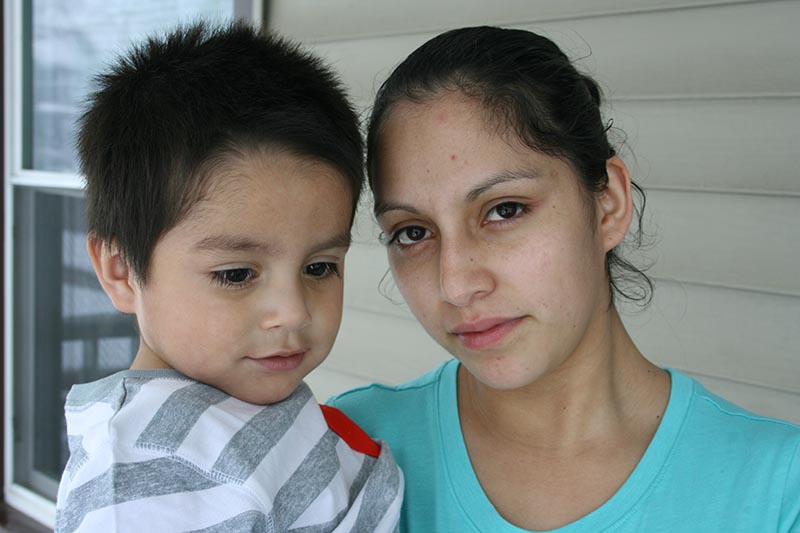Threat of environmental injustice extends beyond Flint

About a year ago Grand Rapids resident Myichelle Mays, 25, picked up her young son, De'Mari, now 4, from a sitter, and immediately knew something was wrong.
De’Mari, who had been diagnosed with asthma just before his first birthday, “was gasping for air,” she recalled. “He couldn't breathe. You could hold him and hear the wheezing. I freaked out.”
Mays rushed the boy to the hospital, the latest of five or six trips to the emergency room since he was infant. Now it is a fear she lives with each day.
“It's stressful, not knowing what is going to happen.”
It was a frightening episode, but one familiar to thousands of low-income minority families in Michigan. And it might be one more reason to view Flint's water crisis as merely the latest chapter in a long narrative in which impoverished residents of color are more likely to bear the brunt of environmental hazards.
According to the Michigan Department of Health and Human Services, black children have four times the hospitalization rate for asthma of white children, according to data collected between 2011 and 2013. In Detroit, hospitalization rates for African Americans of all ages was four times higher than whites for asthma. Eight of the top 10 zip codes in 2014 for asthma hospitalization were in Detroit, which is overwhelmingly black.
While the triggers for asthma are complex, it is linked both to environmental pollutants such as car exhaust and industrial particulates and agents in the home. Many Detroit neighborhoods also rank at the top in Michigan for exposure to airborne pollutants.
And so it is with lead. In 2014, seven of the top 10 zip codes for unsafe lead levels in children under 6 years old in Michigan were in Detroit, in areas of high poverty that are largely black.
Number 13 on the list was a zip code in Grand Rapids that is 70 percent black and Hispanic. More than one-third of these residents live in poverty, and 86 percent live in homes were built before 1970, when the use of now-banned lead-based paint was common.
A troubling link
Lead is a neurotoxin that hinders development of the brain and nervous system, particularly in young children because of the rapid growth of the brain the first few years of a child's life. While lead in the water was the culprit in Flint, in most cases high lead levels in children are tied to crumbling lead paint particles that lurk on the walls and floors in aging homes, which are more likely to be occupied by the poor and minorities.
Lead exposure is one of many ways in which poor families of color in Michigan are more profoundly exposed to airborne pollutants that can damage their health, according to one expert. Add it up and it tells a story of widespread, disproportionate, environmental exposure from air, water, soil – and yes, the home.
“We do see the concentrations of pollutants and contaminants in neighborhoods where people of color live,” said Paul Mohai, a University of Michigan professor specializing in environmental research and policy and founder of its Environmental Justice Program.
“These are also areas with older housing stock, constructed at a time when use of asbestos and lead paint and lead pipes were standard construction material. It is understandable there is a risk not only to these neighborhoods, but to these homes.”
Donnell White, executive director of the Detroit chapter of the NAACP, has reached the same conclusion. “Michigan has a much bigger problem than Flint,” White said.
“You find these kind of triggers no matter if you are talking water quality, air quality, housing stock issues and lead paint – these demarcate along communities of color and communities of high poverty. You see it in Detroit and Hamtramck, where the lead levels in kids are just as high as in Flint, if not higher.
“It is a huge area for us to do a lot of work in.”
Indeed, analysis of EPA and census data by Bridge Magazine found that minorities are more likely to live in areas with the oldest homes – homes that are more likely to contain lead-based paint, which was not banned until 1978 – and even more likely live in areas of highest pollution. Low-income residents are also more likely to live in areas of high pollution.
A task force appointed by Gov. Rick Snyder issued a stern report in March on the Flint water crisis, calling it a story of “government failure, intransigence, unpreparedness, delay, inaction and environmental injustice.” The group specifically noted that the Flint community most affected by the lead-poisoned water is heavily poor and African American.
“When we convened,” Ken Sikkema, Republican co-chair of the task force, told legislators on Tuesday, according to the Detroit News, “we had the same conversation that a lot of people have had, both privately and publicly: If this had happened in East Grand Rapids, in Kent County where I live, or in Bloomfield Hills in Oakland County, would the same result have occurred?”
The task force also found the state's controversial emergency manager law contributed to the lead contamination crisis by removing governmental checks and balance and called for alternatives to the law so elected officials can be kept more engaged.
Mohai, the U-M expert, agreed with the task force’s findings, calling Flint “the most egregious case” of environmental injustice he has seen.
But Mohai's work indicates that Flint is only one of several areas in Michigan where poor, minority populations pay a heavier price for pollution.
Hazards of living near industry
Mohai was a key researcher in a 2010 study of toxic chemical releases in Michigan, built on 2006 data from the U.S. Environmental Protection Agency.
That study concluded that zip code 48217 in southwest Detroit was the most polluted in the state. It is a grim, blighted area bisected by Interstate 75 and surrounded by towering smokestacks used for coal and steel production, salt mining and tar sands crude oil refining. It is about 85 percent black, with more than 40 percent living in poverty. Five nearby zip codes also made the state top 10 pollution list.
In 2011, Mohai looked at public schools across Michigan and calculated their exposure to air pollution. He found 82 percent of black students and 62 percent of Hispanic students attended schools in areas with high levels of industrial pollution, compared with 44 percent of white students.
Industrial pollutants tallied in the study included lead, manganese, sulfuric acid, nickel and chlorine, chemicals “suspected of producing a wide variety of health effects, including increased risk of respiratory, cardiovascular, developmental,and neurological disorders, as well as cancer.”
The study also found that air pollution concentrations were “statistically significant predictors” of poorer student performance, even when correcting for variables such as school expenditures and student demographics.
National studies have found that minority communities are more exposed to these pollutants, presumably because they are more likely to live closer to freeways and in neighborhoods abutting industrial sites. Asthma is also tied to agents in the home, including indoor pollen, mold and second-hand smoke, with studies finding that 40 percent of attacks are linked to factors in the home.
In the 50 Michigan zip codes with the highest rates of asthma hospitalizations, 76 percent of residents are minorities and 35 percent are living in poverty.
The residue of poverty
In Detroit, Henry Ford Health System physician Elliott Attisha connects the city's high rates of asthma to a treacherous cocktail of environmental factors, including airborne pollution and asthma-triggering agents in the home. But he said it's also tied to the residues of poverty that both limit access to health care and can elevate stress, which in turn is linked to asthma.
“A lot of these homes don't have a car,” said Attisha, who directs a mobile health program aimed at asthma and other health care issues that affect Detroit school children.
“They don't have a primary care physician. When you are not getting health care, that's when you end up in the emergency room. In some of these homes you have mold, you have cockroaches, you have smoke, all these exposures that can play a role in asthma.”
Attisha cited a 2015 study which examined psychological causes of advanced stress on children, such as divorce, drug use in the home, the incarceration of a parent or witnessing adults in the home punch or beat each other up.
In homes with one of those factors present, the study found a 28 percent greater chance a child would develop asthma. In homes with four factors, the likelihood of developing asthma was 73 percent greater.
“Poverty creates anxiety. There is a correlation between anxiety and asthma,” Elliott said.
“I can’t breathe”
A couple years ago, Kyaira Hailey, 29, had her first skirmish with the fear of asthma when her young daughter, DeAsia Matthews, began complaining: “I can't breathe.”
A single mother who lives on Detroit's west side, Kyaira summoned her sister, who was living in an apartment across the hall. Her sister has a son of her own with asthma, so Kyaira figured she would know what to do.
Her sister looked at DeAsia, now 5, whose abdomen was caved in as she made wheezing sounds as she struggled to breathe.
“She told me I need to take her in fast.”
She rushed to the emergency room, where DeAsia, now 5, was put on a machine to help her breathe. She has been to the emergency room a few times since, often in winter when cold temperatures aggravate her asthma. She now has two different inhalers, which dispense two types of medication.
Though it has been frightening, Hailey said she at least feels better equipped to deal with the next crisis.
“Now I know what to do,” she said.
In Grand Rapids, Rita Rodriguez, 19, recalled a series of events that led to the day she learned how dangerous lead could be to her young son, Santiago, now 2.
A little more than a year ago, she had taken him to an appointment at a federal nutritional supplement program for low-income mothers, where he had his blood drawn in a finger-prick test. It came back at 19 micrograms of lead per deciliter – nearly four times the level of five micrograms per deciliter at which the Centers for Disease Control recommends action for children to reduce the level.
A follow-up test on Santiago using drawn blood from a doctor's visit found his level to be 11, lower, but still concerning.
Not long after, a social worker visited the rental home she shares with her boyfriend and mother-in-law.
“She tell us what lead does,” Rodriguez said. “She said it goes to the brain. She said the kids don't grow like they are supposed to. I was scared.”
Rodriguez lives in zip code 49507, where 11 percent of children under 6 had lead levels above five micrograms per deciliter in 2014, 13th highest in Michigan. By comparison, in the central Detroit zip code of 48206 – 93 percent black, with 45 percent in poverty – 20.3 percent of children under 6 tested above the action level for lead, tops in the state.
(In Flint – in the midst of its water crisis in 2015 – 6.4 percent of children under 6 tested above five micrograms per deciliter for lead)
Troubling lead levels are not confined to minority or poor neighborhoods.
Zip code 49073 – a rural area in Barry County that includes the towns of Nashville and Maple Grove southeast of Grand Rapids – is 98 percent white with just 17 percent living in poverty. That area tested second highest in the state
But a closer look suggests its lead test level in 2014, in which 17.6 percent of children under 6 tested above five micrograms, could be the result of a small sample size rather than a true measure of the problem. Its percentage of levels above five micrograms was 9 percent in 2013, fell to 3.8 percent in 2013 before jumping above 17 percent in 2014. But those were based on just 67, 52 and 51 tests, respectively. By comparison, the results in Detroit zip code 48206 were based on 790, 701 and 651 tests, respectively.
Numerous studies have confirmed the dangers of lead in children, linking it to poor school performance, loss of IQ points and even violent crime.
In 1978, lead was banned in paint and other consumer goods made and sold in the United States. But lead paint in old buildings and surrounding soil is still considered the primary source of lead poisoning in children, as lead-contaminated dust can remain even after surfaces have been stripped or painted over. The U.S. Department of Housing and Urban Development estimated that 86 percent of homes built before 1940 may contain lead paint.
Taking a long-term view, far fewer Michigan children are testing positive for lead poisoning in recent decades. In 2012, 4.5 percent of those tested in Michigan showed elevated lead levels, more than five times than a decade earlier.
The cost of removing lead, or not
HUD also concluded that homes with poor and minority residents are more likely to contain lead paint hazards. Young children most typically ingest lead as they crawl on their hands and knees, pick up dust and dirt and put their hands in their mouths. They may ingest it from soil surrounding the home as well.
And while there are fewer immediate remedies for residents living in neighborhoods exposed to airborne pollution, the remedy for in-home lead paint exposure is straightforward – if vastly underfunded.
Last year, Dr. Eden Wells, chief medical executive of the Michigan Department of Health and Human Services, told Bridge Magazine: “This is still an issue. It’s not going away.”
After the visit with the social worker to the Grand Rapids home of Rita Rodriguez, lead paint specialists arrived with X-ray equipment to detect any lead that might be in the home. After finding it in a couple windows, workers replaced those and other windows in the home. In his last blood test, Santiago registered three micrograms per deciliter, not perfect but below federal action levels. The family suspects Santiago may have been contaminated in a previous, older house he lived in as well.
One program dedicated to reducing lead exposure is Get The Lead Out, a partnership launched in 2005 that includes the city of Grand Rapids and Healthy Homes Coalition of West Michigan, a nonprofit organization that works to eliminate hazards in the homes of low-income families.
The coalition's director, Paul Haan, said there's a long way to go before lead paint is eliminated. He estimated there are 40,000 homes in Grand Rapids that contain lead paint. Most of its funding comes from the federal government, $16 million as of May 2015.
Statewide, it is estimated there are 1.2 million occupied housing units with lead paint. At an average cost of $10,000 per home to remove lead paint, it would cost $12 billion complete that job in Michigan. But in recent years, Haan said, the total in state and federal funding for lead paint removal has been well under $10 million a year. Thus far, Grand Rapids has remediated just over 1,300 homes.
“We are talking a generation to get this done,” Haan said.
See what new members are saying about why they donated to Bridge Michigan:
- “In order for this information to be accurate and unbiased it must be underwritten by its readers, not by special interests.” - Larry S.
- “Not many other media sources report on the topics Bridge does.” - Susan B.
- “Your journalism is outstanding and rare these days.” - Mark S.
If you want to ensure the future of nonpartisan, nonprofit Michigan journalism, please become a member today. You, too, will be asked why you donated and maybe we'll feature your quote next time!


 Grand Rapids resident Myichelle Mays has taken her son, De'Mari, to the emergency room a half dozen times for asthma attacks. (Bridge photo by Ted Roelofs)
Grand Rapids resident Myichelle Mays has taken her son, De'Mari, to the emergency room a half dozen times for asthma attacks. (Bridge photo by Ted Roelofs) DeAsia Matthews, 5, is among thousands of Detroit children learning to live with asthma. (Courtesy photo)
DeAsia Matthews, 5, is among thousands of Detroit children learning to live with asthma. (Courtesy photo) Paul Mohai, a University of Michigan professor specializing in environmental research and policy, said Flint is only one of several areas in the state where poor and minority residents pay a heavier price for pollution.
Paul Mohai, a University of Michigan professor specializing in environmental research and policy, said Flint is only one of several areas in the state where poor and minority residents pay a heavier price for pollution. Grand Rapids resident Rita Rodriguez recalls the day she learned about the dangers posed by elevated lead levels in her son, Santiago: “I was scared.” (Bridge photo by Ted Roelofs)
Grand Rapids resident Rita Rodriguez recalls the day she learned about the dangers posed by elevated lead levels in her son, Santiago: “I was scared.” (Bridge photo by Ted Roelofs)